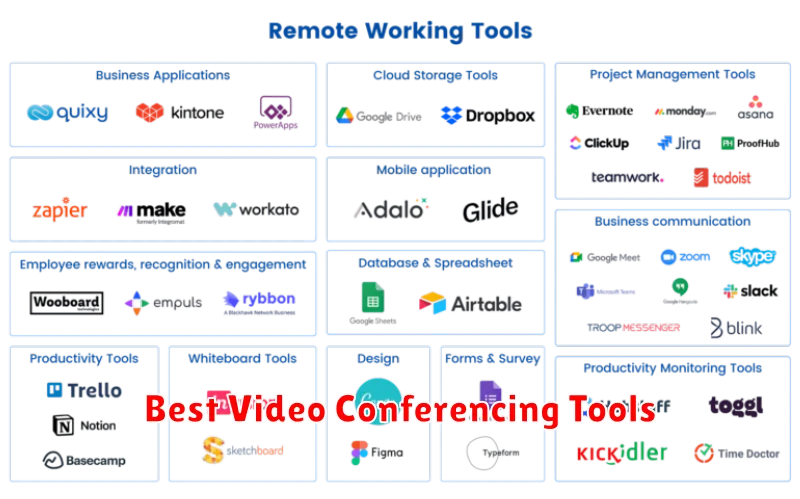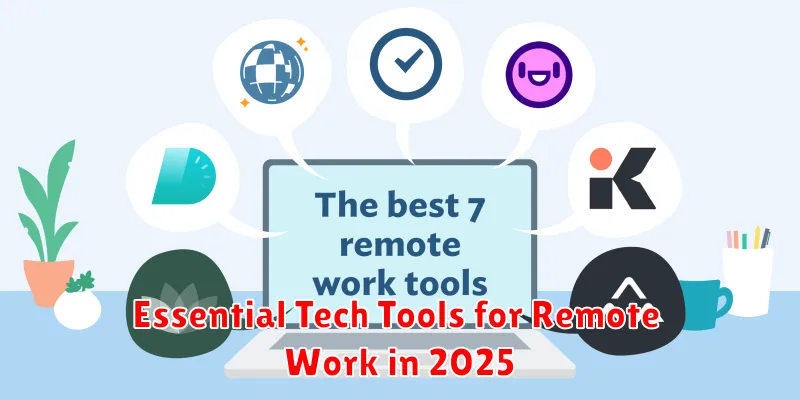The future of work is remote. In 2025, having the right tech tools will be more critical than ever for successful remote work. This article explores the essential tech tools that will empower remote workers to thrive in the evolving digital landscape. From communication platforms and project management software to cybersecurity solutions and virtual office tools, we’ll cover the key technologies that will define remote work in 2025. Mastering these tools will be crucial for maximizing productivity, enhancing collaboration, and ensuring a secure and efficient remote work experience.
Whether you are a seasoned remote worker or just beginning your journey, this guide will provide valuable insights into the essential tech tools you need to succeed in 2025. We’ll delve into the features, benefits, and best practices for utilizing these tools effectively. Discover how to optimize your remote work setup with the latest advancements in collaboration technology, productivity software, and remote access solutions. Staying ahead of the curve with these essential tech tools will be paramount to achieving your remote work goals in the dynamic environment of 2025 and beyond.
Top Collaboration Platforms
In 2025, effective remote work relies heavily on robust collaboration platforms. These tools facilitate communication, project management, and file sharing, keeping teams connected and productive regardless of location. Choosing the right platform is crucial for success in the distributed work environment.
Key features to consider include secure messaging, video conferencing, real-time document editing, and task management capabilities. Integration with other essential business tools is also a critical factor. Below are some of the leading platforms dominating the market:
- Platform A: Known for its robust project management and file sharing capabilities.
- Platform B: Excellent for video conferencing and real-time collaboration.
- Platform C: A comprehensive suite offering a wide range of communication and collaboration features.
Selecting the ideal platform depends on your specific team needs and budget. Evaluate your requirements carefully to ensure optimal performance and seamless integration into your existing workflows.
Best Video Conferencing Tools

In 2025, effective communication remains crucial for remote teams. Video conferencing tools bridge the distance gap, enabling face-to-face interactions vital for collaboration and team building. Choosing the right tool can significantly impact productivity.
Several top-tier platforms offer a range of features:
- Option 1: Known for its robust security and integrations.
- Option 2: A popular choice for its user-friendly interface and breakout room functionality.
- Option 3: Provides advanced features like AI-powered transcription and noise cancellation.
Consider factors such as meeting capacity, screen sharing capabilities, and recording options when selecting the best tool for your team’s needs.
Cloud Storage and File Sharing
In the evolving landscape of remote work, cloud storage and file sharing solutions have become indispensable. These tools provide a centralized hub for accessing and managing work files from anywhere with an internet connection.
Key benefits include enhanced collaboration, streamlined workflows, and improved version control. Teams can work on documents simultaneously, reducing email exchanges and ensuring everyone accesses the most up-to-date versions. Security is also a crucial aspect, with many platforms offering robust encryption and access controls to protect sensitive data. Cloud storage simplifies file management, eliminating the need for local storage and reducing the risk of data loss due to hardware failure.
Time Tracking and Productivity Tools
Effective time management is crucial for remote work. Time tracking tools provide insights into how you spend your workday, enabling you to identify time-wasting activities and optimize your schedule.
These tools often integrate with project management software, facilitating accurate client billing and project budgeting. Beyond basic time tracking, many tools offer productivity features like goal setting, task management, and progress reports. Choosing the right tool depends on individual needs and team workflows.
Secure Remote Access Tools
Secure remote access is paramount in the evolving landscape of remote work. Choosing the right tools ensures both productivity and protection against cyber threats. These tools allow employees to connect to company networks and resources securely from anywhere.
Key features to consider include multi-factor authentication (MFA), end-to-end encryption, and robust access control policies. MFA adds an extra layer of security, while encryption protects sensitive data. Access control ensures only authorized personnel can access specific resources.
Selecting the right tools requires careful evaluation of your organization’s specific needs and security requirements. Look for solutions that offer scalability and integration with existing infrastructure.
Recommended Hardware Setups
Creating a productive remote work environment starts with the right hardware. A reliable and powerful computer is paramount. For most tasks, a modern laptop with a fast processor (e.g., Intel Core i5 or AMD Ryzen 5 or better), at least 8GB of RAM, and a solid-state drive (SSD) is recommended.
High-quality peripherals enhance the experience. Consider a comfortable ergonomic keyboard and mouse, a noise-canceling headset for clear communication, and a high-resolution external monitor for increased screen real estate.
A stable and fast internet connection is crucial for seamless collaboration and access to online resources. A wired connection is preferred, but a reliable Wi-Fi router with good range is a viable alternative.

